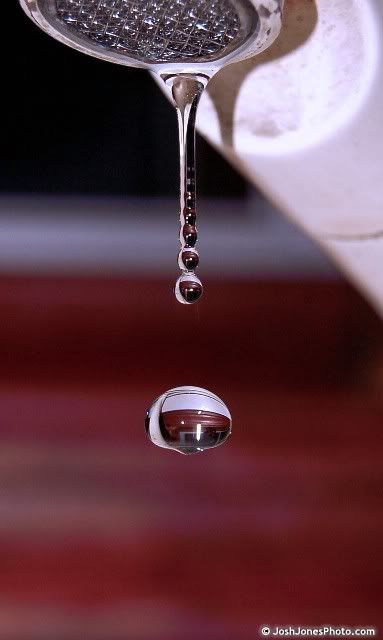
Here are five tips for getting great results with high-speed subjects:
1) Use a fast shutter speed - This is pretty common sense but the faster the shutter speed the more likely that you will rid the picture of all motion blur. You may have to increase your ISO to allow the use of this shutter speed in darker situations. I recommend at least 1/250th of a second for water droplet pictures.
2) Using a flash - A flash is great because it can fire a beam of light that only lasts a tiny amount of time. The extra light from the flash will help allow the use of a higher shutter speed. Trying experimenting with an off camera flash, or a bounce flash for more natural lighting. High wattage lighting setups can be very helpful if you are working in a controlled environment. Basically the more light on your subject, the better.
3) Use manual exposure mode - This is about the only time that I use the fully manual mode on my camera. For shooting things such as water droplets, you need to control the shutter speed, depth of field, and flash output independently. By using a very stopped down aperture, such as f/22, you can get the depth of field needed for the entire water droplet to be in focus. You will need to set your shutter speed manually to something very fast, and you will need to control your lighting output to match your other parameters.
4) Adjust your focus settings - Getting the focus right in these shots is one of the most difficult things about them. A use of a small aperture helps by increasing the depth of field (and thus your margin of error). Many cameras cannot auto focus fast enough to catch a water droplet in mid air. Most just end up focusing on the background. If you have a magic camera that can auto focus so fast it can catch a single droplet midair, please send me an email. For everyone else, you may find that it is easier to switch to manual focus when you know how far away your subject will be. Once you have the focus set properly, then all you need to do is nail the timing.
5) Take a lot of shots - Unfortunately this is a type of photography that demands a lot of trial and error. Nailing the timing perfectly is very difficult. Many of my shots are either taken too late, or before the droplet enter's the frame. Adjust your focus area, depth of field, and shutter speed to see what works best for your setup. The results will be worth it!




I need one of your tutorials on night shooting.... please
ReplyDeleteOld school photos-I remember those from way back when!
ReplyDeleteI took pictures of water droplets when we had a vacation trip at Whitsundays Island. My cousins did scuba diving and surfing there. I also captured a good shot of Tina when she did an acrobat surfing. I used f/1000 shutter speed so the shot of water droplets would freeze. That was my first picture about beach photography.
ReplyDelete